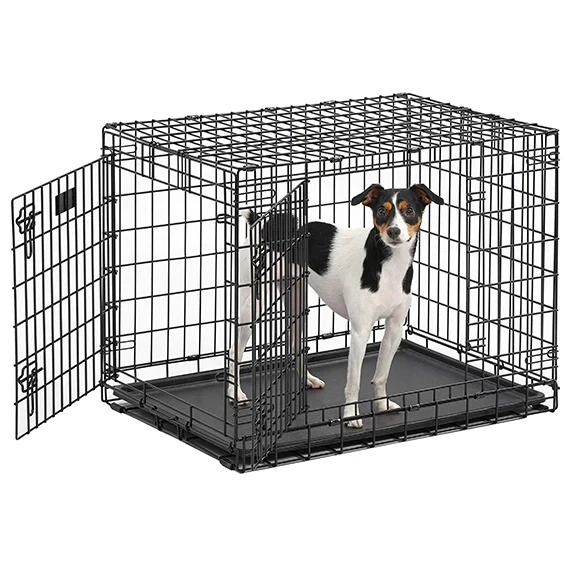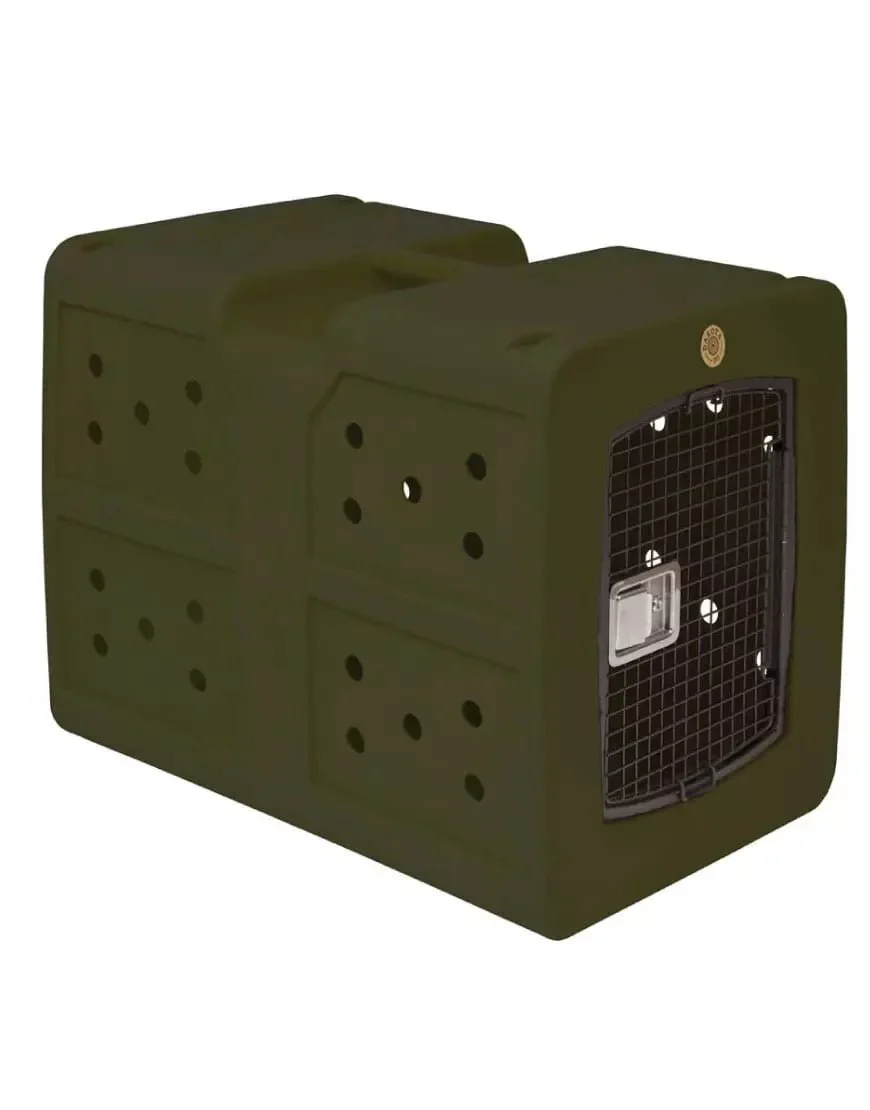**Introduction**
Owning a pet comes with many responsibilities, and choosing the right crate is among the most important ones. A crate isn’t merely a tool for training; it’s a sanctuary where your furry companion can feel secure and comfortable. Whether you’re looking for a crate to use for training, travel, or simply as a cozy space for your pet to relax, this detailed guide will walk you through every aspect of selecting the perfect crate.
**The Role of Crates in Pet Care**
Crates play a vital role in pet care, offering both security and comfort. They are particularly beneficial when traveling or when you need to confine your pet temporarily. Additionally, crates can serve as excellent tools for training, helping your pet develop good habits and behaviors. There are several types of crates available, including plastic crates, wire crates, soft-sided crates, decorative crates, and carriers. Each type offers unique advantages and may be suited to different needs, so understanding their functions is key to making the right choice for your pet.

**Key Considerations Before Buying a Crate**
Before purchasing a crate, there are several factors to keep in mind. The size and weight of your pet, the intended purpose of the crate, the material and construction, and your budget are all critical considerations. Understanding these elements will help ensure you make the best possible choice for your pet.
**Selecting the Appropriate Size Crate**
Ensuring the correct size of the crate is essential for your pet’s safety and comfort. Properly measuring your pet and determining the right crate dimensions are crucial steps. Common mistakes include selecting a crate that is either too large or too small, which can lead to discomfort or even injury.
**Types of Crates and Their Applications**
As mentioned earlier, various types of crates cater to different needs. Plastic crates are robust and easy to clean, while wire crates are portable and offer superior ventilation. Soft-sided crates are ideal for travel, whereas decorative crates blend functionality with aesthetics. Carriers and travel crates are specifically designed for pet transportation.

**Material and Construction Quality**
The quality of the materials and the durability of the construction are paramount when choosing a crate. The crate must be strong enough to support your pet’s weight and endure wear and tear. Ease of cleaning and safety features like secure doors and latches are equally important.
**Accessories and Features to Enhance Comfort**
Adding accessories such as beds, bedding, crate pads, bowls, and water dispensers can significantly enhance your pet’s comfort and safety. Toys and chew treats can also keep your pet entertained and relaxed. Crate covers reduce light and noise, while secure doors and latches ensure your pet remains safely inside.
**Picking the Right Travel Crate**
If you plan to travel with your pet, selecting the right travel crate is imperative. Airline regulations are a significant consideration, and the crate should meet these requirements while being appropriately sized and constructed for your pet. Preparing your pet for travel is equally important.
**Crate Training Your Pet**
Crate training is a highly effective method for teaching your pet good behavior and routines. The benefits are numerous, but it’s crucial to follow a structured approach and avoid common pitfalls during the process.

**Frequently Asked Questions**
**Can my pet stay in the crate all day?**
Leaving a pet in a crate for extended periods is generally not advisable. Although crates can be useful for training and providing a safe space, prolonged confinement can lead to physical and emotional distress, including dehydration, muscle atrophy, and anxiety. It’s essential to give your pet regular exercise, social interaction, and mental stimulation throughout the day.
If you need to leave your pet alone for an extended period, consider hiring a pet sitter or dog walker to provide breaks and attention. Alternatively, setting up a designated pet area with access to food, water, and toys can keep your pet comfortable and entertained while you’re away.
**How do I clean a crate?**
Cleaning a crate involves removing all bedding, toys, and other items first. Use a pet-safe cleaner with warm water to scrub both the interior and exterior, focusing on soiled areas. After rinsing thoroughly with water, let the crate air dry completely before putting anything back inside.
Regular cleaning is vital to prevent bacteria, odors, and other contaminants from building up, which could harm your pet’s health. The cleaning frequency depends on how often your pet uses the crate and how dirty it gets. Generally, it’s wise to clean the crate weekly, more frequently if necessary.
Choose a pet-safe cleaner without harsh chemicals or toxins. Such products are widely available at pet supply stores or online. Avoid using bleach or other harsh substances that might harm your pet.
Spot cleaning is also essential. If your pet has an accident or spills water in the crate, clean it immediately to stop bacteria or mold growth. Keeping your pet’s crate clean ensures their health and happiness.
For peace of mind regarding cleanliness, check out Dakota Guard dog crates from Dakota 283.

**Can I leave water in the crate?**
Whether to leave water in your pet’s crate depends on the situation. For extended periods of confinement, providing water is essential to prevent dehydration. Using a spill-proof bowl or attaching a water bottle to the crate can prevent spills.
However, when crate training and using the crate for short periods, removing water might be preferable to avoid accidents inside the crate. Always provide your pet with water and bathroom breaks before and after crate time.
In general, ensure your pet has constant access to water, especially in hot weather or after physical activity. If you decide to leave water in the crate, use a secure container and check out our spill-proof water bowl for dog crates.
**How long does it take to crate train a pet?**
The time required for crate training varies based on factors like your pet’s age, temperament, and prior experiences. Some pets adapt quickly, while others may need more time and patience.
Crate training typically takes anywhere from a few days to several weeks—or longer in some cases. Success hinges on introducing the crate gradually and positively, rewarding your pet with treats, praise, and other incentives to create a favorable association.
Begin by placing the crate in a quiet area of your home and encouraging your pet to explore it freely. Once your pet feels comfortable entering and exiting, start feeding them meals inside the crate and gradually increase the time spent inside with the door closed.
Never force your pet into the crate or use it as punishment. Instead, make the crate a welcoming space by adding bedding, toys, and treats, and always reward your pet for going inside.
With patience and consistency, your pet can learn to enjoy their crate and feel safe and secure within it.
**How do I choose a travel crate for my pet?**
Selecting the right travel crate demands careful thought. Here are some factors to bear in mind:
1. **Size**: Ensure the crate is spacious enough for your pet to stand, turn around, and lie down comfortably but not overly large to prevent sliding during travel. Accurately measure your pet and pick a crate size that accommodates their movement.
2. **Material**: Travel crates come in various materials like plastic, metal, or fabric. Plastic crates are durable and easy to clean, while fabric crates are lightweight and portable. Choose a material suitable for your pet’s needs and travel conditions.
3. **Ventilation**: The crate should have adequate ventilation to ensure your pet breathes easily during travel. Look for crates with ventilation holes or mesh panels.
4. **Security**: The crate must be secure and capable of handling travel stresses. Opt for crates with sturdy construction and reliable locks.
5. **Compliance**: When flying, confirm the crate meets airline specifications regarding size, materials, and ventilation.
6. **Comfort**: The crate should be comfortable, with padding or bedding to create a cozy and safe space during travel.
By taking these factors into account and selecting a travel crate tailored to your pet’s needs, you can guarantee a safe and comfortable trip. Explore Puppy Fever Pro’s range of dog crates for ideas.
**Conclusion**
Selecting the right crate is vital for your pet’s comfort, safety, and overall wellbeing. This comprehensive guide has covered everything you need to know about choosing the perfect crate. From understanding the purpose of crates to considering size, material, and accessories, you now have the knowledge to make an informed decision.
Remember to consider your pet’s size and weight, the crate’s purpose, the quality of materials and construction, and your budget. Accessories like beds, bedding, crate pads, bowls, and toys can further enhance your pet’s comfort and safety.
Whether you’re searching for a crate for training, travel, or simply a cozy retreat for your furry friend, choosing the right one is essential. With the guidance provided here, you can select the ideal crate for your pet and ensure their comfort and safety for years to come.
Mianyang Shengshi Health Technology Co.,Ltd , https://www.shengshiaminoacid.com